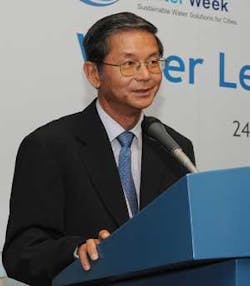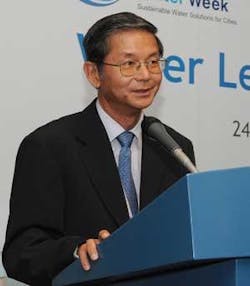A Water Model for the World
By Carlos David Mogollón, Managing Editor
With a bevy of awards for its rapid innovation in water efficiency and reuse as well as plans for the next Singapore International Water Week, PUB Singapore CEO Khoo Teng Chye tells how the island nation became Asia’s R&D hub for the water industry.
In the last several years, Singapore has spent $5 billion to achieve one main goal – water independence. Beyond that, it also has managed to become THE hub for the water and wastewater industry in Asia.
Lying at the southern tip of Malaysia and just north of of Indonesia, the 700-square-kilometer island not quite the size of New York City has a population of 4.7 million that’s expected to grow to 6.5 million in coming decades. A growing industrial base of electronics, biomedical sciences, and petroleum and chemical processing in addition to that means more water needs.
The country faced this challenge with both a four-pronged and three-pronged effort, says Mr. Khoo Teng Chye, CEO since December 2003 of PUB, Singapore’s national water agency. Before that he headed up Singapore’s Urban Redevelopment Authority, PSA Corp., which is in charge of Singapore’s ports, and Mapletree Investments, as well as Temasek Holdings, which owns and manages the Singapore government’s direct investments.
Mr. Khoo also sits on the boards of PUB Consultants Pte Ltd, the Tropical Marine Science Institute of the National University of Singapore, International Desalination Association and Singapore-Delft Water Alliance. And he’s an advisory committee member for the Nanyang Technological University School of Civil & Environmental Engineering.
The four-pronged approach involves, one, continued water supply contracts with neighboring Malaysia that Singapore wants to reduce its reliance on; two, urban stormwater harvesting via a network of reservoirs; three, the NEWater program which collects used water via a Deep Tunnel Sewerage System, recycles it via four (soon to be five) advanced membrane filtration plants built since 2002, and markets it for industrial reuse; and, lastly, a 30-MGD desalination plant that opened in 2005 to provide another source of potable water.
The three-pronged strategy involves a campaign to concentrate in Singapore the technological and research and development (R&D) edge to make it a global center for the water improvement industry, said Mr. Khoo, who controls a S$330 million [US$220 million] fund as executive director since 2006 of the government-funded Environment & Water Industry Development Council toward that end.
“R&D is in the middle,” he said. “The first is technology. We have this money coming in to create these programs to encourage R&D. And that has helped to develop the industry cluster in Singapore (drawing in companies like Black & Veatch, CH2M Hill, Siemens, GE and Pall) and also to help the industry reach out to the world, whether it’s this region, Europe, the Middle East and so on. We thought one of the ways to do that was to create this annual event. It’s not just about the research and technology, but also about getting the message out there and getting people to come.”
The third prong is Singapore International Water Week – which drew over 8,500 people from nearly 80 countries in its debut last June. It also saw deals signed worth over S$367 million (US$270 million) and a number of international initiatives to boost water research and investments detailed in earlier WWi reports. Organizers expect the exhibition portion of the event to grow by 25% in 2009, when it’s held June 22-26.
Below are a few snippets of the interview with Mr. Khoo during the IWA World Water Congress in Vienna, Austria, in September. Click here to read “An Interview with PUB Singapore’s Khoo Teng Chye” in full in Q&A format. Otherwise, read on to learn more:
WWi: You mentioned that rainwater harvesting was a big part of what PUB has been engaged in to overcome its water supply issue.
Mr. Khoo: We are probably the only city in the world that does urban stormwater harvesting on a very large scale. Half of Singapore is a catchment. We have 14 reservoirs and we are building three more. We are building the Marina reservoir and two more in the northeast. By the year 2010, we will have 17 reservoirs and two-thirds of Singapore will be a catchment.
WWi: Tell us about the NEWater program, the reclamation plants and how they figures into the equation, if you could.
Mr. Khoo: Today, we have between 15-20% of our supply that already comes from NEWater. We have four NEWater plants… and one coming in Changi. These are all using RO membrane technology, so the quality of the water is very high. Now, NEWater is primarily used in Singapore for non-potable use. In other words, we send it primarily to industry.
Industries like microelectronics, the manufacturers of silicon chips and silicon wafers, they need very high quality water for their process. And, so, NEWater fits the bill. We sell to them at a good price, so they actually save money buying NEWater. And it’s a higher quality water, so they actually save costs since they don’t have to treat it further… By the year 2010, we will have 30% recycled water supplying us from NEWater sources.
WWi: I noticed you don’t call it wastewater or sewage.
Mr. Khoo: When I talk to you about used water and water reclamation plants, it’s even the choice of words. It’s so important that we pick the right words so that you convey to the public the idea that water is a resource. It’s a closed loop, and what we are doing is really treating the used water and reclaiming the water…
Our approach is holistic in the sense that we not only look at the water supply holistically, we also try to look at the whole water issue holistically as well… On the demand side, it’s more than just water conservation. It’s also about the idea of getting the private sector, the public and the people really to be joint stakeholders for water… We had a very elaborate public relations and public education campaign to promote NEWater…
We bottled it for the public to see and taste it… At national day parade in 2002, we did this… All the national leaders were there and they drank it as a toast to the nation. There were 60,000 people at the stadium and everybody drank NEWater. This is part of what we did to get the public behind it.
For more information on the Public Utilities Board (PUB) of Singapore, visit: www.pub.gov.sg

